Tailfin Bar Bag System review: modular, quick-release handlebar baggage for your bike
Ultra-stable roll bar bag completes Tailfin’s set of luggage for two-wheel adventures, from modest day rides to multiday epics

Tailfin has done it again. It’s produced a ridiculously expensive product that’s also ridiculously good at what it does. Its new bar bag system is stable, secure, cleverly designed and a joy to use. Sadly, there is a price to pay for excellence.
-
+
Very stable
-
+
Incredibly secure
-
+
Can be mounted and removed with the flick of a lever
-
+
WaveLock closure system is so easy to adjust
-
+
Valve aids compression
-
+
Accessory mounts are a useful addition
-
-
Heavy
-
-
Setup takes time
-
-
Not everyone will appreciate the value
You can trust Cycling Weekly.
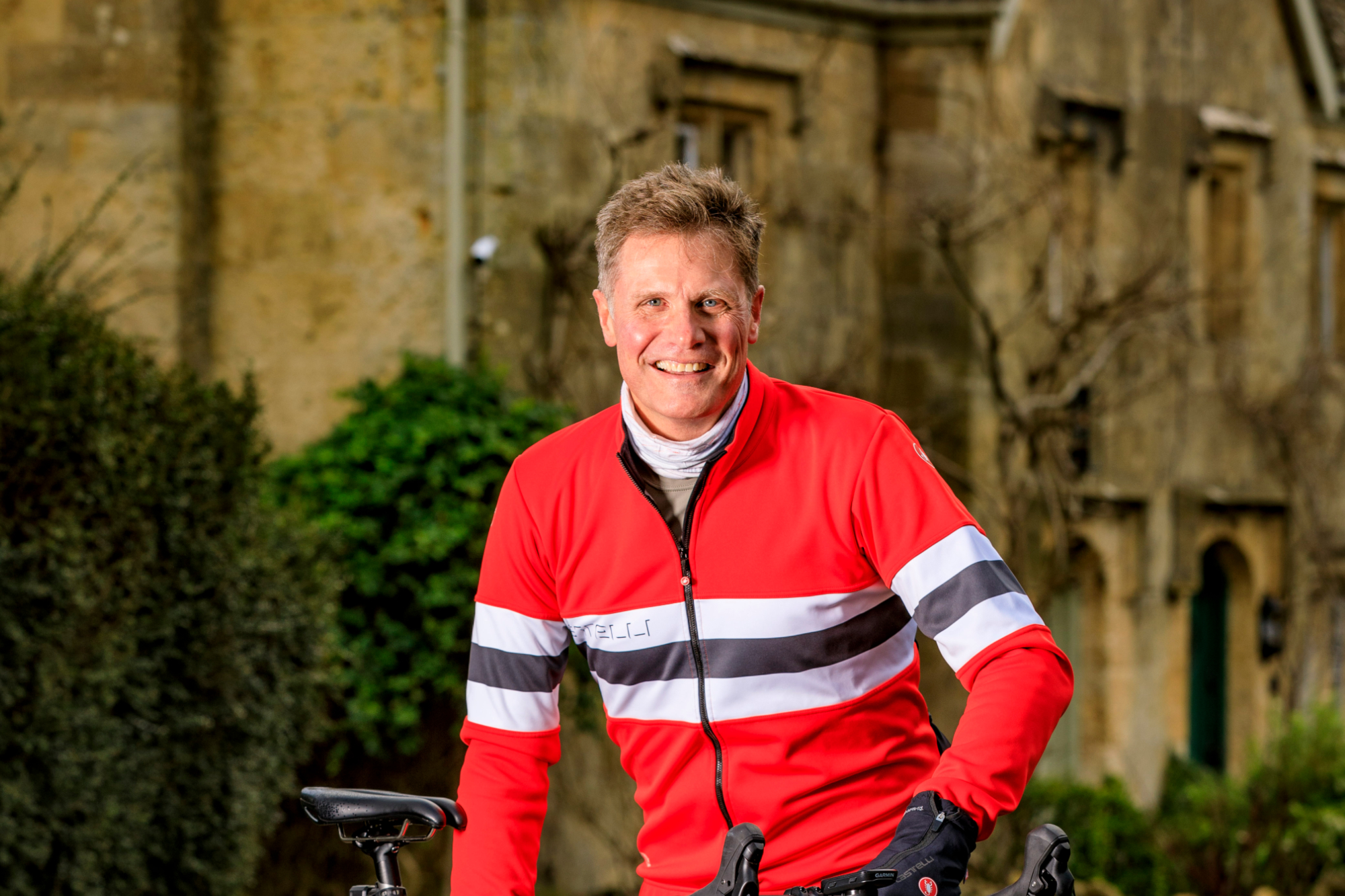
Tailfin - the clue is in the name - first developed a rear bag solution in 2017, and has been pressing forward ever since, both in popularity and the positioning of its products. After first expanding into frame and top-tube bags, it’s now reached the front of the bike with a handlebar system. It’s part roll bag, part harness bag but mostly it’s something completely different that aims to take the benefits of both existing systems but add stability, modularity and ease of use.
I invested – trust me, it’s the most appropriate word – in a Tailfin Aeropack last year, in readiness for a bike-packing trip across northern Spain and Mallorca. Despite the high cost, £299 for a 20-litre bag and an alloy arch, I have no regrets, it performed peerlessly and continues to do so despite a couple of minor ‘offs’. The two qualities that make it a keeper are stability, there’s zero tail-wagging of the sort I’ve experienced from some large seat packs, and ease of removal from the bike.
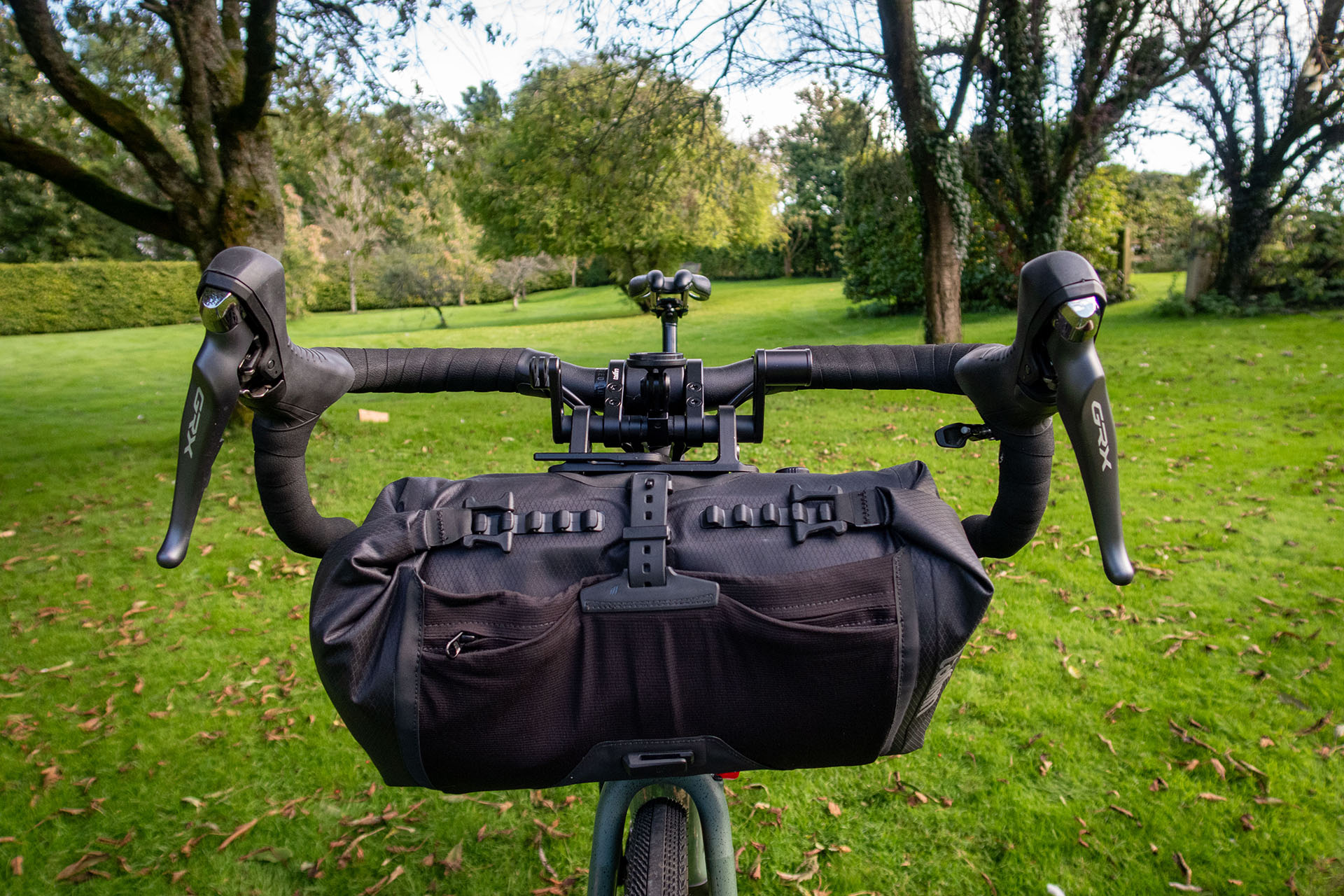
The bag is secured by a rugged aluminium mount system rather than fabric straps. Note Tailfin's new WaveLock closure system.
With the new Bar Bag System, Tailfin’s engineers have set out to solve similar baggage issues, this time up front. Most bar bags are secured to the handlebars by straps, sometimes via a holster. This method can introduce a few problems, including unwanted movement and, if you’re riding drop bars, restricted space on the tops to rest your hands.
Removing a bar bag can also be a bit fiddly, less so for holster-style rigs but that solution isn’t so neat when you need to take a ride without a bag. You’ll be left with a large, unsightly harness in place. Bar bags are also notorious for rubbing against the headtube and generally interfering with hoses and cables.
Tailfin hopes to eliminate these problems by introducing a two-part alloy mount system that features a quick-release X-clamp, which locks the bag securely in place quickly and easily. The system is modular in that the clamp is compatible with all four bags in the range, which vary in capacity from 9.1 litres to 18.9 litres, so you can swap and change as your needs dictate and/or your bank balance allows.
Two of those bags are optimised for drop bars – 9.1 litres and 12.5 litres – and two for flat bars – 14.7 litres and 18.9 litres. However, Tailfin has told me that, provided there is room to fit them, the larger flat bar bags are compatible with drop handlebars and vice versa.
Construction
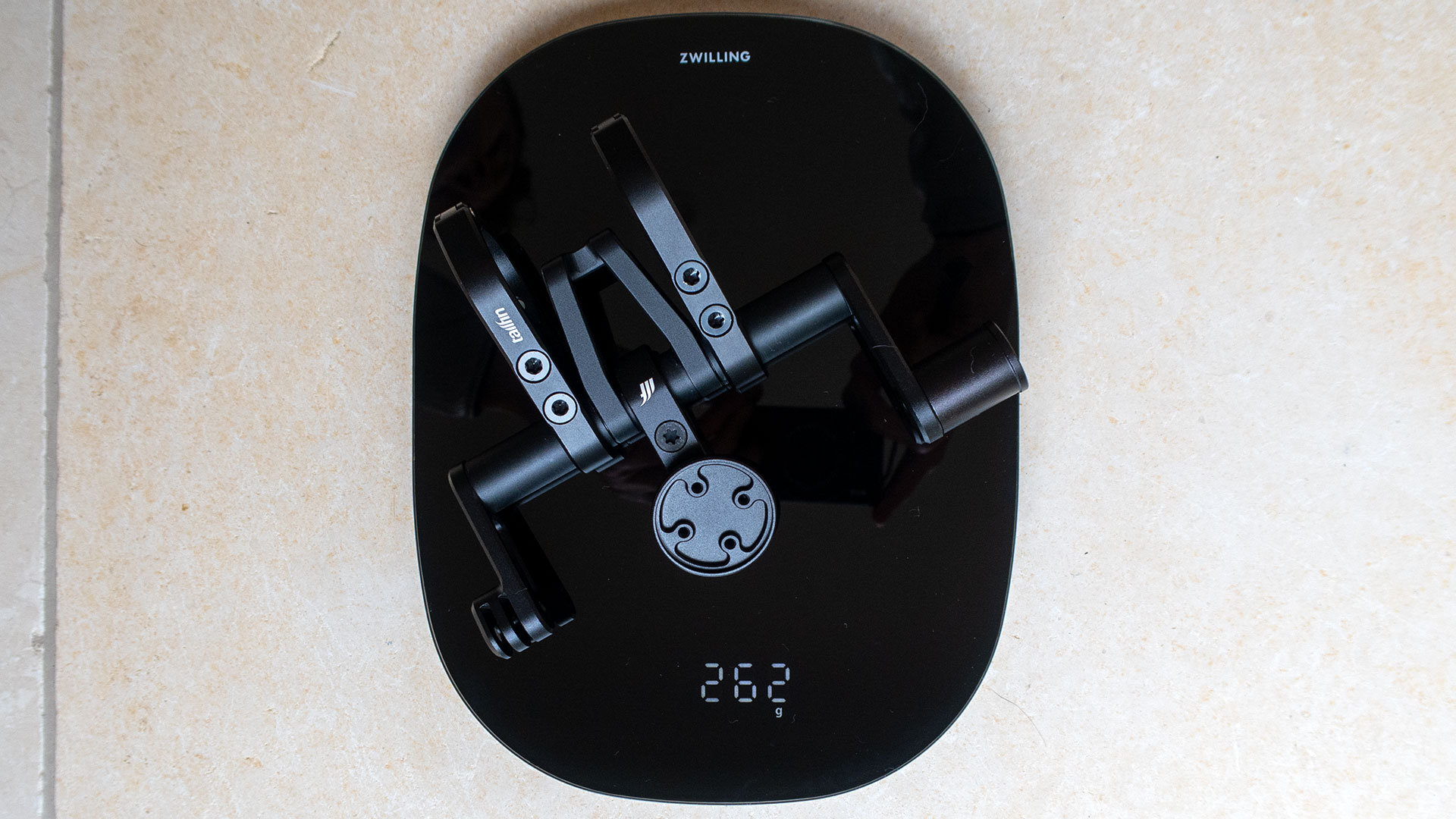
At 262g the mounting bar - with accessory mounts - is quite a substantial addition to your bike.
The system comprises three parts: a roll top bag, an aluminium mounting bar and hook, which affixes to the handlebars, and the aluminium X-clamp and frame that adheres to the bag to provide a docking interface and structural support.
I was provided with a Size Large 12.5 litre drop bar bag for the purpose of this review, but all sizes share very similar features and construction. The bags are made from a combination of Hypalon and Ripstop Nylon fabric, with fully welded seams to keep water and dust out. Tailfin has used Hypalon in areas of high wear, reserving Nylon for the parts that need to remain more flexible.
The primary, roll-top compartment is straightforward enough. Like many roll-top bike dry bags it takes just two full folds at each end to make it fully waterproof, but the volume can be reduced by introducing more. Where the flat bar bag uses traditional closure straps and buckles the drop bar version is fitted with Tailfin’s new low-profile WaveLock closure. This, it says, maximises capacity and is less likely to impede your hands for braking, which is reassuring. Instead of folding the end-straps back on themselves and buckling them to form a loop, Wavelock is fastened by tightening a couple of stirrup-like buckles to two lines of hooks on either side of the bag.
The bags also feature external storage, with multiple front pockets, including a zipped security compartment, that can be cinched down with a built-in Voile-style TPU strap. At the rear is a smaller, kangaroo-style pouch for stowing snacks and rubbish. All of these external pockets are made from a stretchable mesh fabric, so they’re more capacious than they first appear.
Handlebar bags can make placing accessories, such as bike computers, lights and cameras, a real frustration, so it’s refreshing to find that Tailfin has developed a range of mounts that fit directly onto the mounting bar. These can be bought as optional extras.
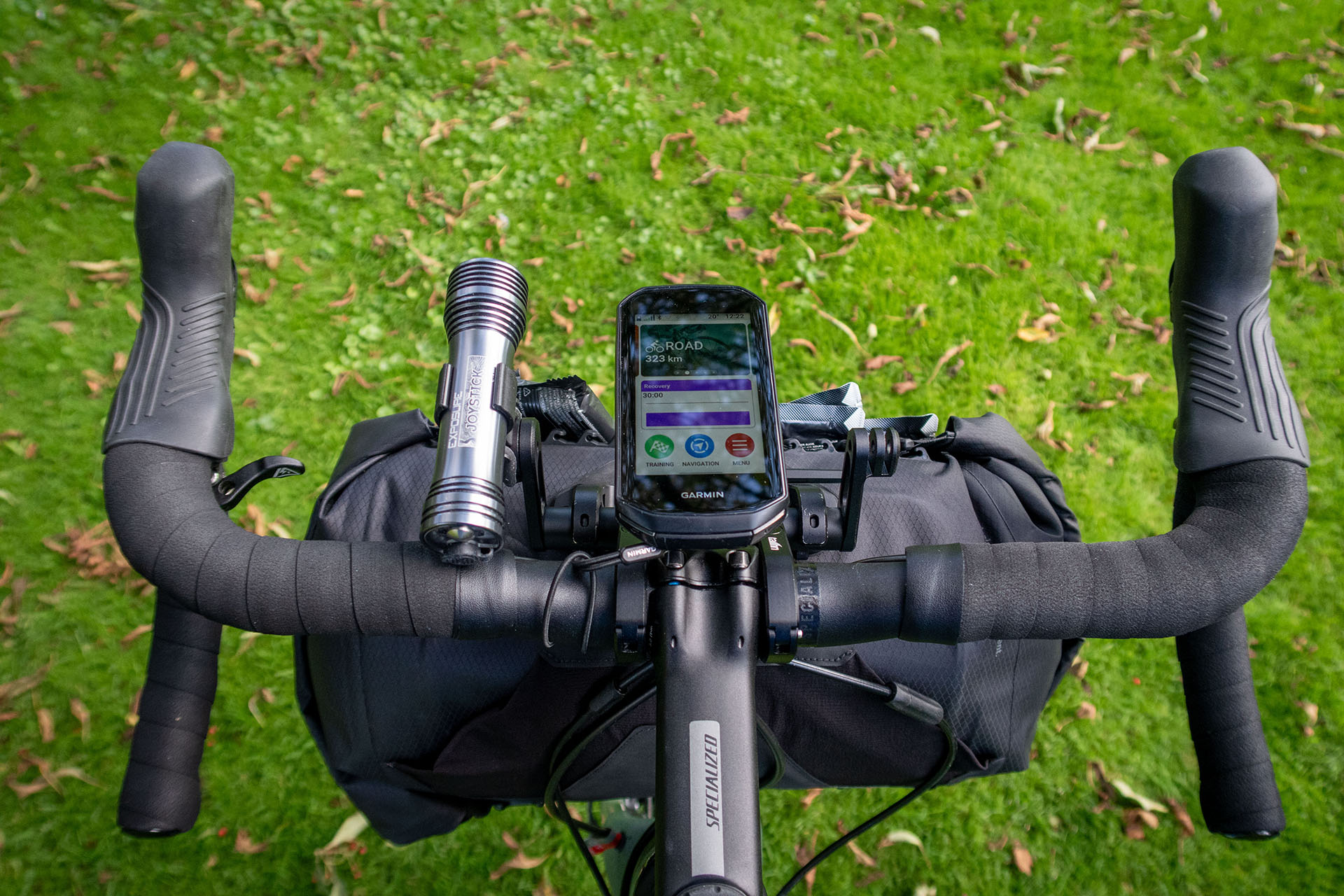
The accessory mounts are very well thought out but they do make installation of the whole system more complex.
The Ride
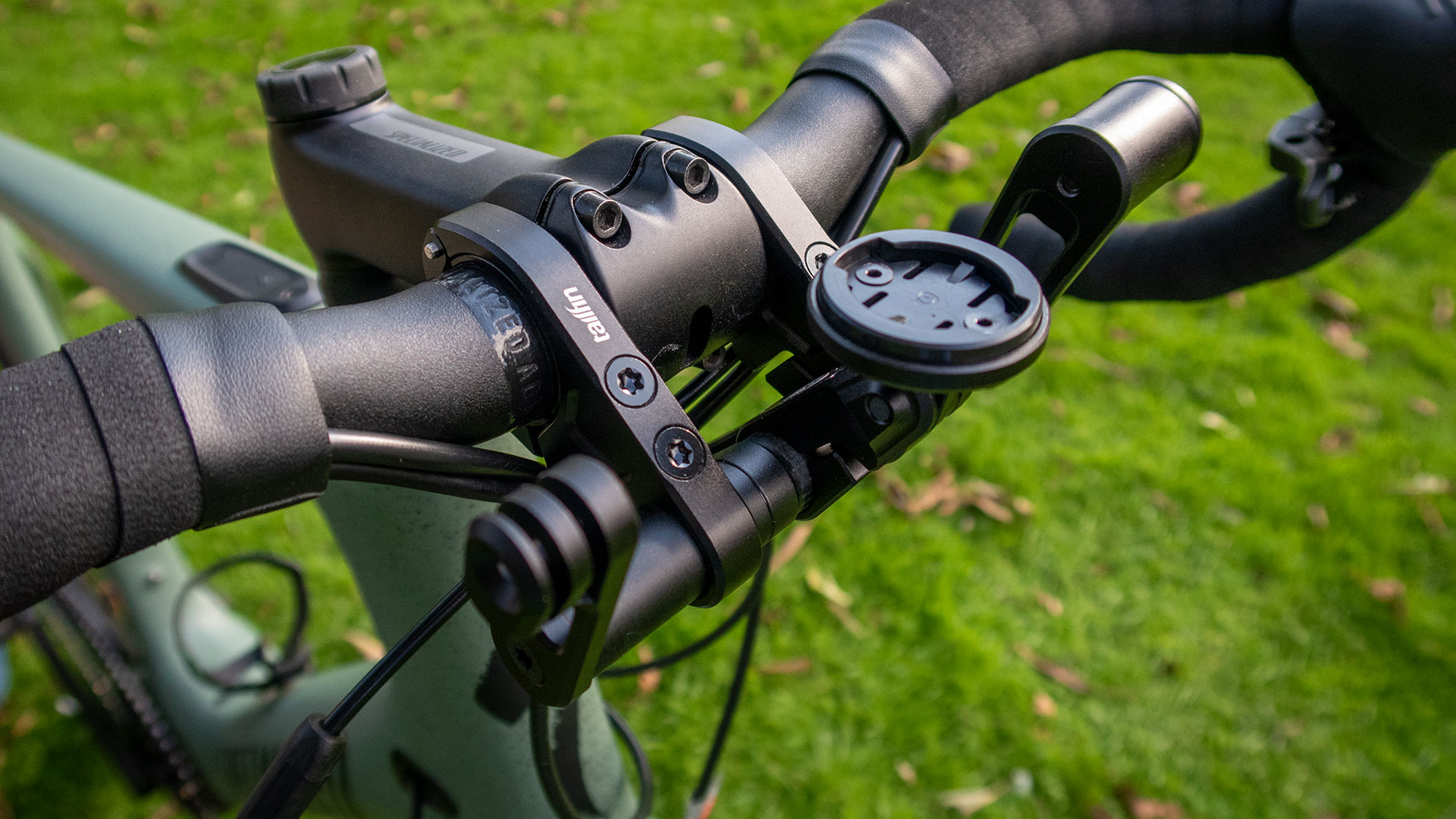
The mounting bar is rugged and has two axes of adjustment for installation. Pictured here with the accessory mounts in place.
Before heading off into the sunset with a Tailfin bar bag, I recommend setting aside time for installation, because the process is a little more involved than fastening a few straps. It took me about 30 minutes in all to align the mounting bar, X-clamp, bag and accessory mounts to my satisfaction. That said, it’s a once-only job that now allows me to mount and dismount the bag in an instant.
The first task is to loosely install the mounting bar onto the handlebars with a couple of clamps. These are compatible with 31.8 or 35mm round-tubed handlebars, so if your bike is fitted with a shapely, integrated carbon aero cockpit, you may be out of luck. Similarly, even if you have round carbon bars it’s best to check with the manufacturer whether they can support both the clamping force and/or a heavy bar bag. Tailfin recommends a total load weight of 5kg, which doesn’t sound like much but, in my experience, it’s plenty to have strapped to your primary method of steering.
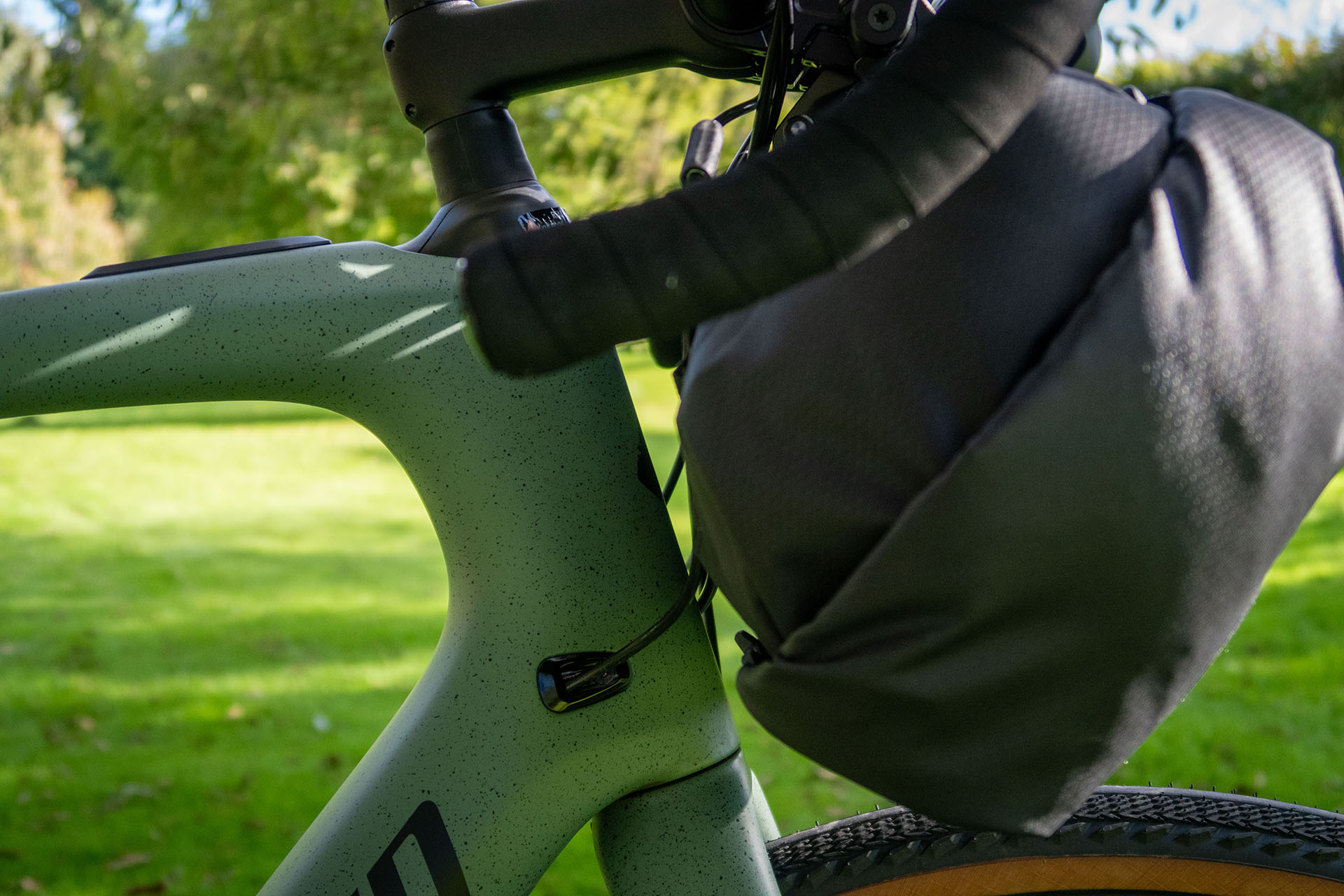
Tailfin recommends a gap of approx 15mm between bag and headtube.
The mounting bar clamps sit quite closely together, so most users should be able to fit them tight up to either side of the stem, which is w here the handlebar is designed to take the load. The clamps are quite slim so, depending on the width of the stem, there may be room to fit aero bars to the bike too.
Ideally, to maintain good bike handling, you’ll want the bag to be as far back towards the headtube and as far down towards the front tyre as possible, without touching either. Tailfin recommends 15mm between the back of the bag and headtube and 20mm between the bottom of the bag and the tyre, which isn’t a lot.
There are two axes of adjustment to play with, the rotation of the clamps on the handlebars and the rotation of the mounting bar. These give a near-infinite level of adjustment, but I also found they provide a near-infinite number of positions that were almost right but not quite, which was frustrating. This was exacerbated by the long headtube on my XXL bike and the quarter-turn computer accessory mount. When every other component was pretty much in place, it would sit too close to my stem to enable me to twist in my chunky Garmin Edge 1050. In the end, I decided to compromise, leaving the headtube space spot on, but the gap above the tyre too big. I blame, both my large frame and my lack of patience.

This is a create space to pack lightweight compressible items such as sleeping bags.
Packing the main dry bag compartment is a joy, Tailfin has done a great job with the WaveLock closure system. I prefer to seal one end of a double-ended bag before loading it because it enables me to more easily compress expandable items such as sleeping bags. So, after folding up one end and latching it securely about mid-way along the two rows of hooks, the first item I chose to stuff into my new bag was a Mammut Relax down sleeping bag. Compressing such items is made easy by the small valve that can be opened to release surplus air, before being locked down as the bag takes on that vacuum-packed look. Playing the valve, it was possible to keep folding and repositioning the stirrups on the WaveLock hooks until I’d reached maximum compression and minimum size.
The external pockets are, well, just pockets really so they packed without too much trouble, and I found it easy to pluck gels from both front and back pouches while on the move. The Voile-style strap is a bonus if you plan to max out the front pockets, but I found it slightly awkward to adjust when they’re only about 25 percent full. Maxed out, they’ll add 2.75 litres of capacity to the 12.5 litre bag.

Open the lever and the bag is released. Such a simple and speedy process.
Installing the loaded bag onto the handlebar really is a case of just dropping it on to the mounting bar – there’s a small anti-rotation bar that will hook into place in the process - and tightening up the X-clamp by turning a small lever. The bag is then securely fixed to your bike.
Out riding, the first thing I noticed was that there was plenty of room to grip the tops, though it’s worth noting that this space will only be available to you if you pay attention when installing the mounting bar. The second thing on my radar was that I could still trigger my dropper post via the handlebar remote, but it was such a close thing I may have to reposition it - of course, this issue is not exclusive to the Tailfin.
Finally, this bag is superbly stable, with zero side-to-side movement. I didn’t encounter any back-and-forth movement either, but then I’d packed the bag with light, compressible sleep kit. If I’d thrown a heavy camera in there, some sway would have been inevitable, but it would have been confined to the contents of the bag. There’s no way this bag is going to swing about on the handlebars, it’s fixed.
Value and conclusion
This new Tailfin Bar Bag system is reminiscent of the BarJam Harness 2.0 from Rockgeist, which features a mounting bar that clamps to the handlebars and supports a holster. It is cheaper at $185, but less sophisticated and doesn’t include a drybag.
There are plenty of other holster systems available, including the excellent 14 and 17 litre Bar Bags from Restrap that cost £99.99 and £135.99 respectively. The 14 litre version weighs 389g, which is significantly lighter than the 817g the 12.5 +2.75 litre Tailfin drop bar bag tips our scales at.
I feel I’ve been here before. The Tailfin Aeropack is heavier than the competition and it’s more expensive, yet it has an enormous following because it really is that good. I believe Tailfin’s Bar Bag System will follow a similar trajectory.
You can get by with a much cheaper solution. I know, because I toured Spain with a 20 litre drybag that I already owned, slung under a pair of £45 Van Rysel aero bars secured with a couple of Oxford ROK straps. This dirt-cheap makeshift setup didn’t let me down during more than 1,000km of cycling but it was a pain to balance and secure on the bike every day.
The Tailfin Bar Bag system is optimised for the job, that’s the difference. Unfortunately, that convenience, that ease of use, will cost you.
Specs
- Small Drop Bar - 4 → 9.1L & 160mm Diameter
- Large Drop Bar - 6.7 → 12.5L & 180mm Diameter
- Small Flat Bar - 5.8 → 14.7L & 160mm Diameter
- Large Flat Bar - 8.7 → 18.9L & 180mm Diameter
- Small Drop Bar | £230 | $300 | €280
- Large Drop Bar | £240 | $315 | €290
- Small Flat Bar | £240 | $315 | €290
- Large Flat Bar | £250 | $325 | €300

Thank you for reading 20 articles this month* Join now for unlimited access
Enjoy your first month for just £1 / $1 / €1
*Read 5 free articles per month without a subscription

Join now for unlimited access
Try first month for just £1 / $1 / €1
Get The Leadout Newsletter
The latest race content, interviews, features, reviews and expert buying guides, direct to your inbox!
Cycling Weekly's Tech Editor Simon spent his childhood living just a stone’s throw from the foot of Box Hill, so it’s no surprise he acquired a passion for cycling from an early age. He’s still drawn to hilly places, having cycled, climbed or skied his way across the Alps, Pyrenees, Andes, Atlas Mountains and the Watkins range in the Arctic.
Simon has 35 years of experience within the journalism and publishing industries, during which time he’s written on topics ranging from fashion to music and of course, cycling.
Based in the Cotswold hills, Simon is regularly out cycling the local roads and trails, riding a range of bikes from his home-built De Rosa SK Pininfarina to a Specialized Turbo Creo SL EVO. He’s also an advanced (RYT 500) yoga teacher, which further fuels his fascination for the relationship between performance and recovery. He still believes he could have been a contender if only chocolate wasn’t so moreish.
-
 'It took everything' - Puck Pieterse outclimbs Demi Vollering to win La Flèche Wallonne
'It took everything' - Puck Pieterse outclimbs Demi Vollering to win La Flèche WallonneDutch 22-year-old shows Classics pedigree with first one-day victory
By Tom Davidson Published
-
 Tadej Pogačar flies to dominant victory at La Flèche Wallonne
Tadej Pogačar flies to dominant victory at La Flèche WallonneSlovenian takes second win at Belgian classic ahead of Kévin Vauquelin and Tom Pidcock
By Tom Thewlis Published
-
 Colombian climbing star and former Vuelta a España winner Lucho Hererra could be investigated over murders of four people
Colombian climbing star and former Vuelta a España winner Lucho Hererra could be investigated over murders of four peopleA judge has called for an investigation into the former Vuelta winner who is alleged to have worked with paramilitary groups in Colombia
By Tom Thewlis Published